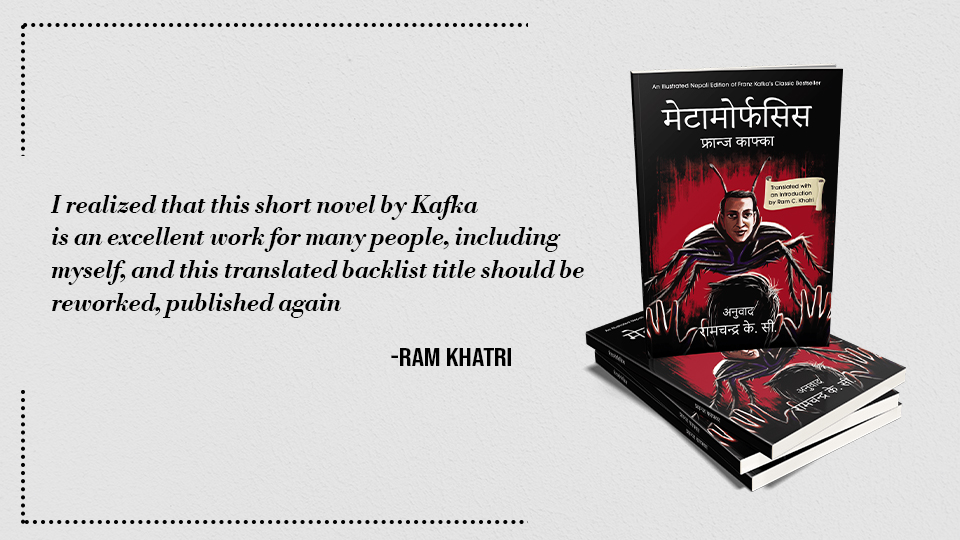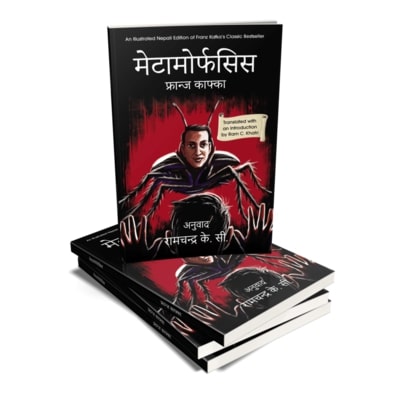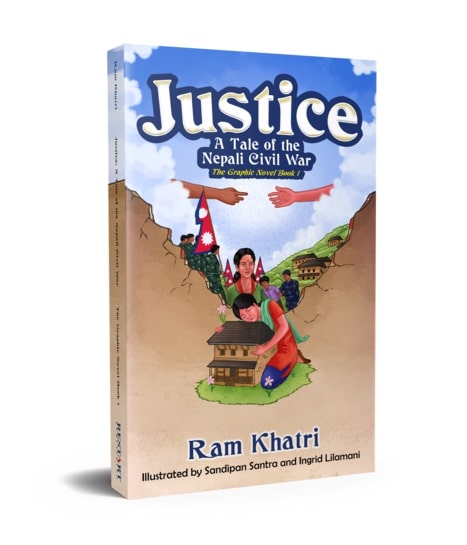
Metamorphosis is a unique work; everyone should read it at least once in their lifetime
“The Metamorphosis is a unique work; everyone should read it at least once in their lifetime.” Sahityapost, an online literary portal from Nepal, interviews Ram Khatri about translation, international publishing, and his new graphic novel
Translator of Franz Kafka’s The Metamorphosis in Nepali, Ram Khatri has worked as the managing editor and publishing manager for academic and commercial publishers in the United States. He holds an M.S. in publishing from Pace University, New York, and an M.A. in English Literature from Tribhuwan University, Kathmandu. Ram is always fascinated by truly diverse, unrepresented, and heart-warming stories that touch lives. Presently, he is involved in book projects, including his upcoming graphic novel Justice which is based on the decade-long “People’s War” in Nepal.
Journalist Krishna Dhungel had a conversation with Ram about international publishing, his translation of Franz Kafka’s The Metamorphosis, and his new graphic novel for Sahityapost, an online literary portal from Nepal.
Let’s start with the book itself, “Metamorphosis’’ – what kind of feedback are you getting from readers about this book?
Firstly, I would like my readers to know that this translated title was kept the same in the Nepali translation just by removing the article ‘The’ from its English title The Metamorphosis. Nouns are not translatable and that the word ‘metamorphosis’ has been synonymous to Franz Kafka. (In fact, a bestselling Nepali author who is also a great fan of Kafka advised me of this idea).
Going back to the first publication of my Nepali translation, Education Book House, a commercial publisher from Nepal, brought it out in the Nepali market over ten years ago and at the time, many people enjoyed this work. The feedback I received was ‘the novella is amazing, the language of Nepali translation flows naturally, and it feels like reading the author’s original work’. Even without marketing and mass media exposures, the book sold well at that time in the Nepali market. As a continuation of those responses and enthusiasm, its modified version has been published in hard cover by Book Hill, another well-known commercial publisher in Nepal, while its illustrated version has been self-published for the international audiences. The current responses are also encouraging.
What made you think “The Metamorphosis book should be translated and re-published”?

When I was majoring in Book Publishing from Pace University in New York in 2015, I was looking for some books in Barnes & Nobel and came across the graphic novel edition of The Metamorphosis which I had once translated. I asked my fellow American friends who were studying with me if they had read The Metamorphosis. I learned that Kafka’s work was highly regarded in the international market as well. After that, I realized that this short novel by Kafka is an excellent work for many people, including myself, and this translated backlist title should be reworked, published again, and everyone should read this book at least once in their lifetime.
Translation is not an easy task. Did you have any special feelings or emotions while translating this book?
Of course! I did not directly translate Kafka’s work from German, the original translation, to Nepali. Since it was “the translation of the translation,” it was very necessary for me to have a deeper understanding and study of this work. For that, I did everything from studying Kafka’s biography to watching movies and documentaries of his works, researching the writer’s ‘source culture’ on the Internet, etc. Subjugating the long sentences and moulding them into your own style was both painful and fun. To be honest, I experienced the joy of creating something unique.
Apart from The Metamorphosis, you have also translated other works. What are your priorities when translating a book?
I have not set any such priorities while translating. For The Metamorphosis, I translated the work out of impatience as the story seemed unique and compelling. Prior to this, I translated a collection of Nepali conflict stories entitled Rebel with the intention of introducing Nepali literature to a global audience. The encouragement and cooperation of Govinda Raj Bhattarai and Balaram Adhikari were very welcoming. (I think these two names should not be missed when talking about the translation of Nepali literature). I have also realized that simply translating any work of literature does not make it global; rather, a lot of factors such as marketing, publicity, and supply chain demands also make a huge impact. In translation, a close collaboration with the editor, especially from the target culture, is a priority for me. This will make sure that the deeply translated terms, the nuances of the source language and culture make sense to the target audience. Likewise, there should be a kind of compromise for both cultures to convey a meaning acceptable to everyone. By ‘compromise’, I meant ‘loss and gain’ on both sides.
What factors should a professional translator consider when translating any text?
It will be crucial to thoroughly research the “source culture,” a language or culture which is translated into different language known as “target culture” or language. The translator should also be a perfectionist, which is another requirement. “Perfectionist” as in someone who enjoys revising and reviewing of his own work multiple times to make it better and better towards perfection.
You are working very hard to enrich the Nepali language and literature while you are living in America. Do you get more connected to your language and literature when you are abroad?
As a student, I was perplexed by accomplishment and what I could achieve. Another factor is that a person shouldn’t be alienated from his language and literature when they travel abroad for employment, or to study. Your native language will always remain with you, no matter what opportunities or setbacks you discover.
Although numerous organizations have been established, Nepali literature has not yet been globalized. Is it our literature, the translators, or something else lacking?
In the context of globalization, ‘mainstream’ becomes a central concept that both American, and international publishers have been “experimenting” a lot to be innovative and competitive in the book business. Digital technology also comes forward in this. Here in Nepal, we are just beginning to use the eBook. The writer should also work a little harder if he wants his work to be globalized. If you look at any American author, apart from writing books, s/he also has knowledge about publishing and marketing, which makes it easier for publishers to work with them. Another thing, I don’t think Nepali literature lacks something. We lack institutional initiative, vision, and leadership.
Where does Nepali literature fit into the global stage? What kind of future do you see?
With a few notable exceptions, Nepali literature is lagging far behind on the global stage. I think not a single Nepali work is a ‘bestseller’ in the international market till now. Here, the fundamental cause is being unable to penetrate the mainstream publishing industry. There have also been a very small number of excellent Nepali literature published from America, but many of them are ‘self-published’ and a few of them are by Big 5 publishers. While interning at a literary agency in New York, I ran through hundreds of author queries along with their manuscripts. I found that a few authors were from India while there was not even a single Nepali author. Some individual initiatives have been taken to bring Nepali literature to the international market, but there have been no institutional initiatives or leadership besides some big talks. I see a good future for Nepali literature in the world market at the age of diversity and globalization.
What are your upcoming plans?

Stories about the American Civil War are still being written or repurposed today, from every new angle, and there are ‘bestsellers’ as well. I’m working on a graphic novel with a conflict story from Nepal. Following its successful crowdfunding campaign on the Kickstarter, I am working on the marketing and publicity of the book entitled Justice: A Tale of the Nepali Civil War (The Graphic Novel Book #1). I was closely involved from story/idea generation to working with script writer, editors, illustrators, graphic designers, and more. “Graphic novel” is a popular genre in the American market as literature is going visual, serialized, and multi-channel publications.
Interested readers can get additional information and download a sample chapter of my graphic novel by clicking on the website and can also pre-order it through Amazon or other major retailers. Nepali audience can also check out Kafka’s Nepali novella following this link: www.kafkametamorphosis.com.

